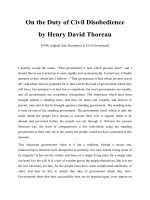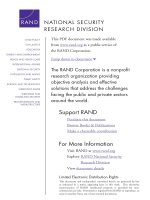Reporters on the Battlefield pot
Bạn đang xem bản rút gọn của tài liệu. Xem và tải ngay bản đầy đủ của tài liệu tại đây (907.37 KB, 176 trang )
This PDF document was made available
from
www.rand.org as a public service of
the RAND Corporation.
6
Jump down to document
Visit RAND at www.rand.org
Explore RAND National Security
Research Division
View document details
This document and trademark(s) contained herein are protected by law
as indicated in a notice appearing later in this work. This electronic
representation of RAND intellectual property is provided for non-
commercial use only. Permission is required from RAND to reproduce, or
reuse in another form, any of our research documents.
Limited Electronic Distribution Rights
For More Information
CHILD POLICY
CIVIL JUSTICE
EDUCATIO
N
ENERGY AND ENVIRONMENT
HEALTH AND HEALTH CAR
E
INTERNATIONAL AFFAIR
S
NATIONAL SECURIT
Y
POPULATION AND AGIN
G
PUBLIC SAFETY
SCIENCE AND TECHNOLOGY
SUBSTANCE ABUSE
TERRORISM AND
HOMELAND SECURITY
TRANSPORTATION AND
INFRASTRUCTURE
The RAND Corporation is a nonprofit
research organization providing
objective analysis and effective
solutions that address the challenges
facing the public and private sectors
around the world.
Purchase this document
Browse Books & Publications
Make a charitable contribution
Support RAND
This product is part of the RAND Corporation monograph series.
RAND monographs present major research findings that address the
challenges facing the public and private sectors. All RAND mono
-
graphs undergo rigorous peer review to ensure high standards for
research quality and objectivity.
3FQPSUFST
POUIF
#BUUMFGJFME
4HE%MBEDDED0RESS3YSTEM
IN(ISTORICAL#ONTEXT
#HRISTOPHER0AULs*AMES*+IM
!PPROVEDFORPUBLICRELEASEDISTRIBUTIONUNLIMITED
4HE2!.$#ORPORATIONISANONPROFITRESEARCHORGANIZATIONPROVIDING
OBJECTIVEANALYSIS AND EFFECTIVE SOLUTIONS THATADDRESS THE CHALLENGES
FACING THEPUBLIC AND PRIVATE SECTORS AROUND THE WORLD 2!.$S
PUBLICATIONSDONOTNECESSARILYREFLECTTHEOPINIONSOFITSRESEARCHCLIENTS
ANDSPONSORS
®
ISAREGISTEREDTRADEMARK
Ú#OPYRIGHT2!.$#ORPORATION
!LL RIGHTS RESERVED .O PART OFTHIS BOOKMAY BE REPRODUCED IN ANY
FORM BY ANY ELECTRONIC ORMECHANICAL MEANS INCLUDING PHOTOCOPYING
RECORDINGORINFORMATION STORAGE AND RETRIEVAL WITHOUT PERMISSION IN
WRITINGFROM2!.$
0UBLISHEDBYTHE2!.$#ORPORATION
-AIN3TREET0/"OX3ANTA-ONICA#!
3OUTH(AYES3TREET!RLINGTON6!
.ORTH#RAIG3TREET3UITE0ITTSBURGH0!
2!.$52,HTTPWWWRANDORG
4OORDER2!.$DOCUMENTSORTOOBTAINADDITIONALINFORMATIONCONTACT
$ISTRIBUTION3ERVICES4ELEPHONE
&AX%MAILORDER RANDORG
,IBRARYOF#ONGRESS#ATALOGINGIN0UBLICATION$ATA
0AUL#HRISTOPHERn
2EPORTERSONTHEBATTLEFIELDTHEEMBEDDEDPRESSSYSTEMINHISTORICALCONTEXT
#HRISTOPHER0AUL*AMES*+IM
PCM
)NCLUDESBIBLIOGRAPHICALREFERENCES
h-'v
)3".PBK
7AR0RESSCOVERAGE)RAQ7AR0RESSCOVERAGE)+IM*AMES*
))4ITLE
0.70
gDC
#OVERDESIGNBY3TEPHEN"LOODSWORTH
4HISREPORTRESULTSFROMTHE2!.$#ORPORATIONSCONTINUINGPROGRAMOF
SELFINITIATEDRESEARCH3UPPORTFORSUCHRESEARCHISPROVIDEDINPARTBY
DONORSANDBYTHEINDEPENDENTRESEARCHANDDEVELOPMENTPROVISIONSOF
2!.$SCONTRACTSFORTHEOPERATIONOFITS53$EPARTMENTOF$EFENSE
FEDERALLYFUNDEDRESEARCHANDDEVELOPMENTCENTERS
iii
Preface
While the history of relations between the press and the military pre-
dates modern journalism, much of what had gone before was neu-
tralized by the horrible press-military breakdown that occurred dur-
ing U.S. involvement in Vietnam. By the end of the Vietnam War,
press-military trust was at an all time low, and antagonism on both
sides at an all time high. Many in the press, feeling repeatedly misled,
reported ongoing events in an unfavorable light; many in the military
felt betrayed by this “inappropriate” and negative press coverage and
wanted to have nothing further to do with the press. Following Viet-
nam, the tension between First Amendment protections, generally
accepted citizen “right to know,” and military resistance and desire
for operational secrecy has led press-military relations through several
different institutional forms. First, the complete exclusion of the press
from the intervention in Grenada, followed by the better but less-
than-satisfactory “press pool” systems used in Panama and during the
first Gulf War, and the “turning of the tables” in Haiti and Somalia,
where the press was in country before the troops, concluding (for the
present) with the “embedded press” system, in which journalists are
attached to, and travel with specific military units. The embedded
press system appears to be the best solution to date at balancing the
needs of the three core constituencies (the press, the military, and the
public); the questions remain whether that appearance is correct,
what improvements remain to be made, and what, if any, vulnerabili-
ties (for any of the constituents) the embedded press system creates.
iv Reporters on the Battlefield: The Embedded Press System in Historical Context
This research focuses on the embedded press system deployed
during Operation Iraqi Freedom and should be of interest to those in
the armed forces, the media, policymakers responsible for regulating
press access, as well as the public at large. It attempts to answer the
following questions: How effective was the embedded press system in
meeting the needs of the three main constituencies (the press, the
military, and the citizens of the United States)? What policy history
led to the innovation of an embedded press system? Where are press-
military relations likely to go in the future? These questions are an-
swered through an evaluation of the embedded press system, a set of
lessons learned from press-military relations during the recent con-
flict, and an analysis of the strengths and weaknesses of the embedded
press system (or its descendants) for possible future operations.
This research was conducted within the International Security
and Defense Policy Center (ISDP) of the National Security Research
Division (NSRD), a unit of the RAND Corporation. NSRD con-
ducts research and analysis for the Office of the Secretary of Defense,
the Joint Staff, the Unified Commands, the defense agencies, the De-
partment of the Navy, the U.S. intelligence community, allied for-
eign governments, and foundations.
This book results from the RAND Corporation’s continuing
program of self-initiated research. Support for such research is pro-
vided, in part, by donors and by the independent research and devel-
opment provisions of RAND’s contracts for the operation of its U.S.
Department of Defense federally funded research and development
centers.
For more information on the RAND International Security and
Defense Policy Center, contact the director, James Dobbins. He can
be reached at ; 310-393-0411, ext. 5134;
RAND Corporation, 1700 Main Street, Santa Monica, California
90407-2138.
v
Contents
Preface iii
Figures
ix
Tables
xi
Summary
xiii
Acknowledgments
xxiii
CHAPTER ONE
Introduction 1
The Origins of “Embedded Press”
1
Defining the Key Constituencies in Military-Press Relations
3
Methods
4
Significance of this Research
5
Structure of the Book
6
CHAPTER TWO
The Relationship Between the Press and the Military:
A Starting Point
7
The Press
8
Mission Focus: Reporting
8
Institutional Characteristics
10
Press Goals for News Coverage
14
The Military
17
Mission Focus: Protection and Defense of the United States
18
Institutional Characteristics
18
Military Goals Related to News Coverage
21
vi Reporters on the Battlefield: The Embedded Press System in Historical Context
Comparison of the Press and the Military 26
Goals of the Press or Military Vis-à-Vis the Public
28
The Public’s Goals for News Coverage
29
Press-Military Relations
30
Conclusion
34
CHAPTER THREE
History of Relations Between the Press and the Military 35
Case Studies: The Legacies of History
36
Vietnam: A Critical Juncture in Press-Military Relations and a
Massive Legacy of Mistrust
36
Grenada: Backlash Against the Press
39
Panama: Press Pool Doesn’t Work
40
First Gulf War: Coverage But Not Access
42
Somalia: The Press Turns the Tables
46
Haiti: Prelude to Cooperation
47
Bosnia and Kosovo: Proto–Embedded Press System
48
Afghanistan: Special Forces Are Hard to Cover
50
Major Combat Operations in Iraq: The Triumph of
Embedded Press
51
Observations
57
CHAPTER FOUR
Systems for Press Access and Measures for Evaluating Outcomes 63
Systems for Organizing Military-Press Relations
64
Access Strategies for Organizing Press-Military Relations
64
Operational Security Strategies
68
Summary of Systems for Organizing Military-Press Relations
70
Implementation of Systems for Managing Press-Military Relations
72
Measures for Evaluating the Embedded Press System
74
CHAPTER FIVE
Preliminary Evaluations of the Embedded Press and Other
Systems for Organizing Press-Military Relations
77
The Embedded Press System
78
Military Goals and Measures
78
Contents vii
Press Goals and Measures 83
Public Goals and Measures
89
Comparison of Embedded Press and Other Systems for Organizing
Press-Military Relations
91
Military Goals and Measures
91
Press Goals and Measures
95
Public Goals and Measures
96
Implications for Coverage of Future Conflicts
98
The Consequences of Different Contexts on Press-Military Relations
100
Legacies of Previous Conflicts
100
Technology
101
Planning and Lead Time
101
Nature of the Operation
102
Quality of Opposition
104
The Value of Victory
105
The Price of Failure
106
Conclusion
108
CHAPTER SIX
The Future of Embedded Press 109
Widespread Applause
110
Possible Shortcomings
110
The Embedded Press System Created a Hierarchy of Credentials
111
The “Soda-Straw” View of War
111
Loss of Objectivity
112
Technology and the Consequences of the 24-Hour News Cycle
113
Professionalism and Preparation of the Media
114
Suggestions for Future Research
114
APPENDIX
A. The Public’s “Right to Know” 117
B. Outcomes and Measures of the Embedded Press System
123
Bibliography
139
ix
Figures
2.1. Those in the Public Following a Particular Issue Versus the
Number of Articles Mentioning a Country in Which the
U.S. Military Was Involved
31
5.1. Volume of News Coverage of Selected Countries over Time
80
5.2. Public Opinion of Attention Press Gave to Various Topics
During War in Iraq
85
xi
Tables
S.1. Comparison of Press and Military Missions and Goals xv
2.1. Comparison of Press and Military Missions and Goals
27
3.1. Summary of Cases, News Coverage Issues, and Legacies
58
4.1. Notional Relative Design Properties of Access and Security
Strategies
71
4.2. Major Access and Security Strategies During Significant
Combat Phase of Selected Operations
73
4.3. Outcomes and Measures for Press-Military Relations
74
5.1. Support for Decision to Go to War in Iraq
81
5.2. Sources of Public Information About Iraq
86
5.3. Notional Values of Measures of Different Operations
92
5.4. Relative Media Coverage Ratings
97
5.5. Generic Expected Outcome Effects from Different
Systems of Press-Military Relations
99
B.1. Public Opinion Data—Reasons for Support of Iraq War
128
B.2. Credibility Ratings for Sources of Information on Using
Military Force in Foreign Affairs
130
xiii
Summary
The March 2003 U.S. invasion of Iraq coincided with the first broad
implementation of an innovative means of wartime coverage known
as “embedded press.” Under this system, over 600 reporters from a
diverse range of American and international news organizations were
“embedded” in U.S. military units, i.e., they traveled with the soldiers
in their units, saw what the soldiers saw, and were under fire when
troops were—all while bringing live televised coverage of the war into
living rooms around the world.
Although the embedded press system has been heralded as a
great success, no systematic evaluation of this system has yet been un-
dertaken. This research seeks to address this need by examining the
role of the embedded press in Iraq within the broader context of his-
torical press-military relations. In particular, we focus on the tensions
arising from long-standing differences between the military and the
press with regard to the dissemination of information during war-
time: While the military is focused chiefly on preventing information
of value from falling into enemy hands, the press aims to broadcast
the full story to the public.
To examine the role of the embedded press, we have constructed
an evaluative framework that considers the goals of the press, the
military, and the public—the three relevant constituencies for press-
military relations. We use this framework to develop a set of measures
for evaluating the embedded press system in relation to other options
for organizing press-military relations as revealed through compara-
tive case studies. We have conducted preliminary analyses, where pos-
xiv Reporters on the Battlefield: The Embedded Press System in Historical Context
sible, using these methods, which will be appropriate for future sys-
tematic analyses.
The Potential for Conflict Arises from the Different
Missions of the Press and the Military
As is to be expected, the press and the military have different missions
and characteristics, as well as different goals with regard to wartime
news coverage. These differences are highlighted in Table S.1. Of
special significance is the contrast between the press’s focus on its
mission of reporting and the military’s focus on its operational mis-
sion. The press’s interest in gaining access to information so that it
can inform the public (both to fulfill its obligations to the public and
to garner profits and/or ratings for its parent organization) can come
into direct conflict with the military’s need to ensure operational and
informational security.
Despite these key differences, the military and the press do share
certain commonalities. Both aspire to a high level of professionalism,
and both focus on serving the public, albeit in very different ways.
The military exists to defend and protect the United States and its
territories, while the press exists to keep the public informed; both
roles are considered critical to a healthy democracy. But while both
institutions serve the public interest, there is a tension between re-
porters’ need for access to information and the military’s need to
maintain operational security. Surveys have shown that, in resolving
this tension, the public has consistently favored the military’s need for
operational security over the press’ desire for full disclosure. None-
theless, the public also has goals of receiving a high level of war cover-
age and in being “well-served” by such coverage.
Summary xv
Table S.1
Comparison of Press and Military Missions and Goals
Press Military
Mission
Reporting Protection and defense of the United States
Mission-Related Goals
Uphold obligations to the
public
Achieve profits
Achieve operational success
Maintain operational security
Organizational Attributes
Horizontal/competitive
Reflexive
Reactive
Professional
Hierarchical/cooperative
Reflexive
Reactive and Proactive
Professional
Goals for News Coverage
Gain access to newsworthy
information
Provide newsworthy
information to the public
Fulfill obligations to
the public
Build market share
Maintain quality of news
Objectivity (tell both sides
of the story)
Accuracy
Credibility
Do not allow news coverage to compromise
operational security
Fulfill legal obligations regarding press access
Use news coverage to support military mission
Obtain good public relations
Build credibility
Support information operations
Tensions Between the Press and the Military Have Led to
a Variety of Press Access Strategies
The history of press-military relations illustrates several critical junc-
tures in the trajectory of their interactions. In Vietnam, the press en-
joyed high levels of access to operations, largely because of the rela-
tively amicable relationship that had developed between the press and
the military, particularly in World War II. However, this relationship
experienced a significant shift during the Vietnam War, as news cov-
xvi Reporters on the Battlefield: The Embedded Press System in Historical Context
erage critical of both the war and the military engendered tensions.
The legacy of these tensions significantly influenced press-military
relations in later operations in Grenada and Panama. Another notable
shift occurred during the first Gulf War, however, establishing the
basis for new kinds of press access, which ultimately led to the em-
bedded press system used during major combat operations in Iraq in
2003.
Embedded Press Is One of Several Options for
Organizing Press-Military Relations
The embedded press system can be considered along a continuum of
idealized options for organizing press-military relations, each of which
involves a particular strategy for press access. At one end of the con-
tinuum for press access is denial of access, under which press coverage
is limited to official sources only. Press pools represent a somewhat
more open system of access, under which a small number of prese-
lected reporters are allowed access to some otherwise unavailable
sources of information; in exchange for that access, reporters pool
their resources with each other. As already noted, embedded press
means that reporters travel with military units, seeing what they see.
At the other end of the continuum is unilateral journalism. Under this
strategy, reporters operate with broad freedom of access, either by
freely joining or leaving troops in the field and traveling on any mili-
tary vehicle with space available; or by participating in the more free-
form “cowboy” or “four-wheel-drive” journalism, in which reporters
reject both the constraint of traveling with the military and any
military-imposed constraints on access.
Access strategies typically interact with different operational se-
curity strategies, including credentialing, under which reporters agree
on their professional honor not to violate the confidence of the mili-
tary; censorship, in which the military unilaterally decides that certain
information cannot be released to the public; and “security at the
source,” under which military personnel agree to be circumspect in
deciding what information to share with reporters.
Summary xvii
To evaluate the success of the embedded press, we developed a
series of measures based on the military and press goals highlighted
above, as well as additional measures related to the public’s interests.
A full list of outcomes and measures can be found in Table 4.3 on
pp. 73–74. In comparing systems for press-military relations, we con-
sidered the ways in which access strategies can interact with different
operational security strategies.
The Embedded Press System Can be Judged as Widely
Successful Across a Broad Range of Outcomes and
Measures
Military Outcomes
Do not allow news coverage to compromise operational security. Al-
though, in the abstract, embedded press is one of the most vulnerable
systems of press-military relations from an operational security stand-
point, our research found that, given the potential magnitude of the
threat, operational security during the major combat operations phase
of Operation Iraqi Freedom (OIF) was generally intact and protected
far more than it was violated. At the same time, operational security
was not perfect, nor was it close to the military’s target threshold of
“secure.” Available evidence indicates that there were fewer than half
a dozen “disembeddings” for violations of operational security, and
there was no evidence of any compromises of operational security in
which Iraqi forces took advantage of violations of security.
Fulfill legal obligations regarding press access. Embedded press as
implemented in Iraq succeeded well in terms of fulfilling legal obliga-
tions. Perhaps at risk to operational security, the military gave broad
access to troops and fighting, while the embedded press made great
quantities of information available to the public, who followed the
war closely.
Obtain good public relations. The embedded press in Iraq, cou-
pled with the decisive military victory and the by-and-large exemplary
performance of U.S. forces, resulted in excellent public relations for
the military. Perhaps the only exception was negative coverage during
xviii Reporters on the Battlefield: The Embedded Press System in Historical Context
the second week of the war. News coverage of the major combat op-
erations phase was carried out with far fewer press complaints than
seen in previous major conventional operations, such as those in Gre-
nada, Panama, and the first Gulf War.
Build credibility. The analysis suggested that the military was
very careful to protect its credibility, and it was reasonably successful
at doing so. Although vague or tentative information released in U.S.
Central Command briefings may have irked the press, the military
took care to avoid making erroneous claims and carefully qualified
the language of uncertainty when relaying unverified reports.
Support information operations. Operation Iraqi Freedom con-
tained two main examples of the military’s successful incorporation of
press coverage in “honest” information operations. The “shock and
awe” campaign at the beginning of the war made the press a willing
participant in showing the advancing might of U.S. armed forces;
while this display did not result in complete Iraqi submission, it likely
had some effect, although this is difficult to measure. Press coverage
was also used effectively to debunk false claims made by the Iraqi
Minister of Information.
Press Outcomes
Establish a satisfactory access arrangement. The embedded press system
as implemented allowed the press unprecedented access. The system
used in Iraq included not only the embedded press, but other forms
of press access, including unilateral reporting and official information
releases from the U.S. Central Command.
Ensure reporter safety. In general, risks to reporters under an em-
bedded press system were comparable to the risks to the soldiers they
were accompanying. The number of reporters killed during the main
combat phase of Operation Iraqi Freedom was thirteen, four of
whom were embedded reporters. Given the relative number of em-
bedded versus unilateral reporters, embedding in Iraq was safer than
reporting unilaterally, but still risky.
Fulfill obligations to the public. The public generally approved of
the coverage of the major combat operations phase of OIF. While
public approval almost certainly results from a variety of factors be-
Summary xix
yond the issue of whether or not the public receives sufficient infor-
mation to exercise their democratic rights, approval can reasonably be
imputed at least in part from the information’s effectiveness in help-
ing people exercise those rights.
Build market share. While we did not seek data about the relative
market success of different press agencies, poll data asking respon-
dents about their sources of information on the war suggest that the
embedded press system created conditions favorable to live television
coverage. It is unclear whether this type of coverage was viewed at the
expense of, or in addition to, other news formats.
Maintain quality journalism. Our view—based on public opin-
ion data, a study by the Project for Excellence in Journalism, and
news analysis—suggests that coverage of major combat operations
during OIF was generally of “good” quality, although there was room
for improvement. In particular, our historical narrative revealed sev-
eral concerns with journalistic quality during major combat opera-
tions in Iraq—most related to fears of patriotic bias or to the poten-
tial for embedded reporters to lose their objectivity because of their
companionship with troops.
Build credibility. Public opinion polls suggest that coverage of
major combat operations during OIF improved the perception of the
media among some members of the public, but worsened the percep-
tion among others. Many felt that reporters were too eager to paint
either a negative or a positive picture of the war, suggesting a baseline
expectation of bias that is not consonant with high credibility.
Public Outcomes
Public satisfaction, information, and service. Several public opinion
polls suggest that, by and large, the public was well satisfied with war-
time coverage.
The Embedded Press System Is Not Without Future Risks
A comparison of the embedded press with other systems of press-
military relations used in previous conflicts suggests that, although, in
xx Reporters on the Battlefield: The Embedded Press System in Historical Context
general, a combination of embedded press and unilateral journalism
has favorable or positive outcomes across the board, there are still po-
tential risks involved, particularly to operational security and reporter
safety. Such risks can be mitigated to a large extent through a system
of credentials to register and to screen reporters, such as that used in
Iraq.
The use of the embedded press system in future operations
could raise additional risks as follows, which also need to be miti-
gated:
• Legacies of previous conflicts. What has gone before matters.
Given the successes of the embedded press system in the war in
Iraq, the majority of stakeholders from the military, press, and
public will expect to see some form of this system used in the
next major U.S. military operation; should that fail to occur,
certain expected “relationship” outcomes, such as military public
relations with the press and the public, are likely to be dimin-
ished simply because of disappointed expectations.
• Developments in technology. Given the changes wrought by tech-
nological innovations such as the real-time global coverage made
possible by advances in portable satellite-based communications,
it is not inconceivable that some future innovation will further
change the nature of coverage and force innovation and change
in future press-military relations.
• Planning and lead time. Longer lead times afford planners the
opportunity to consider press relations well in advance and de-
velop appropriate access strategies. Anything that shortens the
time the press has to prepare (such as crisis operations or se-
crecy) creates constraints on the implementation of certain press
systems, including the potential for embedding reporters.
• Nature of operations. The nature of a military operation can have
an important impact on several press-military outcomes. For ex-
ample, air wars and special operations can be difficult for the
press to cover effectively. Also, as the quality of opposing forces
increases, so too do the risks to operational security and the
danger to reporters posed by embedding.
Summary xxi
• The value of victory. Systems of press-military relations such as
the embedded press system rely heavily on the ability of U.S.
forces to successfully complete their missions with a minimum
of errors. Victory all but assures the military of good public rela-
tions with the population at large and increases the likelihood of
good relations with the press if it is coupled with broad press ac-
cess. In contrast, when military operations go poorly, press-
military relations can come under severe strain, especially if the
press has been granted broad access.
Recommendations for Addressing Other Possible
Shortcomings of the Embedded Press System
Our analysis led us to identify several recommendations for address-
ing potential problems with the use of embedded press in future op-
erations.
• The embedded press system creates a hierarchy of credentials be-
tween embedded reporters and unilateral reporters. To avoid po-
tential resentments and related problems, future systems would
do well to consider credentialing and validating unilateral re-
porters to some extent.
• Although embedded reporters get a close-up view of operations,
that view is also somewhat narrow, producing what has been
called a “soda-straw effect.” This effect can be mitigated to the
extent that the public has access to the views provided by many
“soda straws.” Also, editors or producers can help to ensure that
these views are synthesized into easily digestible reports. In addi-
tion, embedding should continue to be supplemented by other
systems of press access that provide different perspectives.
• Some believe that the embedded press system can lead reporters
to lose their objectivity because they identify too closely with the
soldiers with whom they are embedded. Given the myriad pres-
sures and possible sources of bias that are brought to bear on re-
porters every day, we did not find the potential bias inherent in
xxii Reporters on the Battlefield: The Embedded Press System in Historical Context
the embedding process to be of great concern; however, further
research may be warranted.
• The effects of technology and the 24-hour news cycle should not
be underestimated. Coverage provided by the embedded press,
together with increases in other forms of media coverage, can
exaggerate both good and bad news. Increased coverage makes
information available to the public that had previously been
available only to military personnel, in some cases resulting in
pressure on political and military authorities to respond more
quickly than in the past. This is a real concern for decisionmak-
ers and field commanders alike and may not serve the public in-
terest.
• With the embedded press system, the extent to which risks to
operational security are mitigated depends to a large extent on
the integrity and professionalism of reporters. In order to ensure
that reporters can fulfill their obligations, it will be important
for news organizations to assign experienced journalists to com-
bat operations and to make these reporters familiar with military
operations in advance of their embedding.
xxiii
Acknowledgments
We would like to thank our RAND colleagues Nelson Lim, Susan
Everingham, Rachel Swanger, and Jeffrey Isaacson for their support
and encouragement in undertaking this research. For their helpful
feedback and suggestions, we thank the participants in a RAND
seminar presenting preliminary findings for this book. Special thanks
to the several reporters and military officers who shared their
thoughts and experiences with us; we would thank them each by
name but wish to protect their anonymity.
We also wish to extend our thanks to Eric Larson for allowing
us to use his data on public opinion and media coverage. Thanks,
too, to Jack Snyder, Anibal Perez-Liñan, and Brigitte Nacos for their
helpful comments and feedback on drafts of early parts of this work.
Thanks to Eric Larson and Pittsburgh Tribune-Review reporter Carl
Prine for their helpful reviews of this document during the quality
assurance process.
We truly appreciate the help and support of administrative assis-
tant Maria Falvo, RAND librarian Judy Lesso, and research commu-
nicator Kristin Leuschner; each of them made an invaluable contribu-
tion to our ability to produce this book in this form. Any errors that
remain are the authors’ alone.









